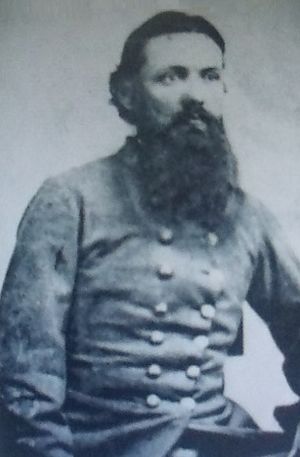Edward Tiffin Harrison Warren facts for kids
Quick facts for kids
Edward T. H. Warren
|
|
|---|---|

Edward T. H. Warren
|
|
| Born | June 19, 1829 Harrisonburg, Virginia |
| Died | May 5, 1864 (aged 34) Locust Grove, Orange County, Virginia |
| Place of burial |
Woodbine Cemetery, Harrisonburg, Virginia
|
| Allegiance | |
| Service/ |
|
| Years of service | 1861–65 (CSA) |
| Rank | |
| Battles/wars | American Civil War |
Edward Tiffin Harrison Warren (born June 19, 1829 – died May 5, 1864) was a military officer who became a colonel during the American Civil War. He led a group of soldiers from Virginia in the Army of Northern Virginia. Sadly, he was killed in action during the Battle of the Wilderness on May 5, 1864.
Contents
Life Before the War
Edward Warren was born in a town called Harrisonburg, Virginia. Before the war began, he worked as a lawyer there.
In 1855, he married Virginia Magruder, who everyone called Jennie. They lived in a house that is now known as the E.T.Warren-Sipe House. Their son, James Magruder Warren, later became a well-known doctor in the area.
Before the war, Edward Warren joined a local group of citizen soldiers called the Valley Guards. He became a lieutenant in this group. In 1859, he was present at the trial and execution of John Brown, who was famous for trying to end slavery. The next year, Warren was elected to the town council, but he left that job when the war started.
Edward Warren in the Civil War
When the Civil War began, Edward Warren's Valley Guards joined a larger group of soldiers called the 10th Virginia Infantry. On August 1, 1861, Warren was made a lieutenant colonel in this regiment.
Early Battles and Promotions
As a lieutenant colonel, Warren fought in the First Battle of Bull Run. His regiment was part of a larger unit led by Edmund Kirby Smith.
Warren became a full colonel on May 8, 1862. This happened after the previous colonel, Simeon B. Gibbons, was killed in the Battle of McDowell.
Serving with Stonewall Jackson
The 10th Virginia Infantry, under Colonel Warren, served with famous Confederate General Stonewall Jackson during his Jackson's Valley Campaign.
- First Battle of Winchester: On May 25, 1862, at the First Battle of Winchester, Warren led his regiment to help another general, Richard Taylor, attack the Union army's left side.
- Stopping a Raid: Warren's regiment also helped stop a Union attack near Port Republic before the Battle of Port Republic on June 9, 1862.
Colonel Warren missed a few battles, like the Battle of Cedar Mountain and the Second Battle of Bull Run. During these times, other officers led his regiment.
Leading Brigades
Warren later led a larger group of soldiers called a brigade during the Battle of Fredericksburg and the Battle of Chancellorsville.
- Fredericksburg: At Fredericksburg, Warren's brigade was held in reserve. They were called forward to help fill a gap in the battle line when Union soldiers broke through.
- Chancellorsville: At Chancellorsville, Warren's brigade was in the second line of Stonewall Jackson's surprise attack. Warren was badly wounded while leading his soldiers in this attack.
Gettysburg and Later Battles
After recovering from his wounds, Warren returned to lead his regiment at the Battle of Gettysburg.
- Culp's Hill: On July 2, 1863, Warren's 10th Virginia fought in the attack on Culp's Hill. His unit moved into an area of the Union position that had been left empty.
- Skirmishes: The next day, his regiment acted as "skirmishers," which means they were spread out to protect the side of the Confederate attack.
- Heavy Losses: The regiment lost almost 40% of its soldiers in this battle.
Warren's 10th Virginia did not fight in the Bristoe Campaign in the fall of 1863. However, they did fight in the Battle of Mine Run, where they faced Union soldiers at the Battle of Payne's Farm.
Death and Legacy
Edward Warren was killed in the Battle of the Wilderness on May 5, 1864. He suffered multiple bullet wounds. He was buried in the Woodbine Cemetery in Harrisonburg, Virginia.
His letters to his wife show that he had strong opinions about other military leaders. For example, he once called another general, Turner Ashby, "rather a humbug." He also expressed frustration about how many of his men were lost under Stonewall Jackson's command.

